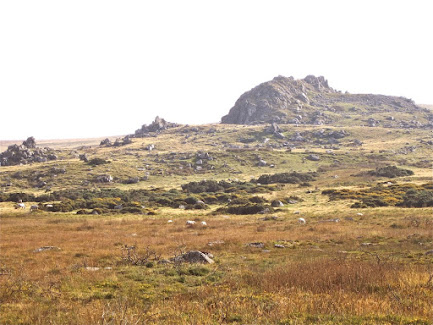New Quay Bay and Little Quay Bay -- where interesting things may be seen.......
There are remarkably few analyses in the literature of the Pleistocene sedimentary sequence at New Quay, on the Cardigan Bay coast between Cardigan and Aberaeron. I'm increasingly convinced that it is rather important........
I examined the coastal sections of New Quay Bay, Llanina Point and Little Quay Bay in 1964 and noted, like other field workers, that the ice of the Irish Sea Glacier had impinged upon the Cardigan Bay coast in many locations to the south of Aberystwyth, but that this ice had seldom managed to force its way far inland. This was probably because of the blocking presence of glacier ice from the Welsh Ice Cap.
Etienne et al, in Ch 7 of "The Glaciations of Wales and Adjacent Areas", refer to Irish Sea tills at New Quay, but I am not sure why they refer to them in the plural. There is but one Irish Sea till, visible in multiple locations along the coast. It has all of the "normal" Irish Sea till characteristics -- a stiff calcareous clay matrix derived from sea floor sediments, contained broken marine molluscs, faceted pebbles and cobbles from a wide range of northerly locations, and a decalcified and reddish upper surface where it is in contact with overlying fluvioglacial sediments. In places there are signs of deformation, and at Llanina (the headland between the two bays) a detached mass of the till is underlain and overlain by fluvioglacial sands and gravels. There are thus indications of complex ice wastage conditions with detached masses of dead ice and considerable debris flowage and redeposition. But the Irish Sea Till clearly all belongs to one glacial episode which affected a great length of coastline.
What is more intriguing is the occurrence at New Quay West, about 300m from the Lifeboat Station, of a thick layer of "diamicton" containing mostly locally derived rock fragments and also many foreign faceted cobbles and pebbles. It is very different from the "lower head" which we see at Poppit West above the raised beach and beneath the Irish Sea till, and different from the stratigraphically equivalent lower head in many Pembrokeshire coastal sites. The New Quay deposit is up to 15m thick, and it varies in colour from purple to grey and grey-brown. There is an irregular contact with the underlying lower head. There are signs of pseudo-stratification, some distinct clay bands and other layers of concentrated stones with fines washed out. There are lenses of sands and gravels, and here and there slumps and other deformational structures can be seen.
Workers have puzzled over this deposit for many years. Frank Mitchell thought it was a local till, Sybil Watson thought it was an ancient soliflucted glacial deposit, and Etienne et al (2005) seemed to be rather unsure what to make of it. In 1965, after making heavy weather of a protracted discussion, I came to the view that it is a true till laid down by Welsh ice which flowed across the coastline, perhaps moving from SE towards NW. I am now more than ever convinced of the correctness of that interpretation, and think that very little time might have elapsed between this NEW QUAY GLACIAL EPISODE and the Late Devensian incursion by Irish Sea ice which has been well documented.
The chart below is from my doctorate thesis, in which I seek to make some sense of the local stratigraphy. I suggest a short periglacial or non-glacial phase between the two glacial episodes, but I would like to get back to New Quay so as to re-examine the evidence.
It's interesting that Etienne et al (2005) refer to another exposure at Llannon where a shelly Irish Sea till overlies "subglacial tills of Welsh provenance". This site is also described in the "Quaternary of Wales" volume edited by Campbell and Bowen, on p 65. They refer to a Welsh till overlain by an Irish Sea till, and argue for a complex interaction between Welsh Ice and Irish Sea ice along the coast of Cardigan Bay. They do not quite resolve the issue of the intense periglacial disturbance of the surface of the Welsh till, which seems to have taken place prior to the laying down of the Irish Sea till. Was there a prolonged periglacial episode with deep permafrost between the two glacial phases?
Somebody, one day, will sort all this out. But today the Cardigan Bay Late Devensian glacial episode looks a bit more complicated than it did yesterday.........



























































































